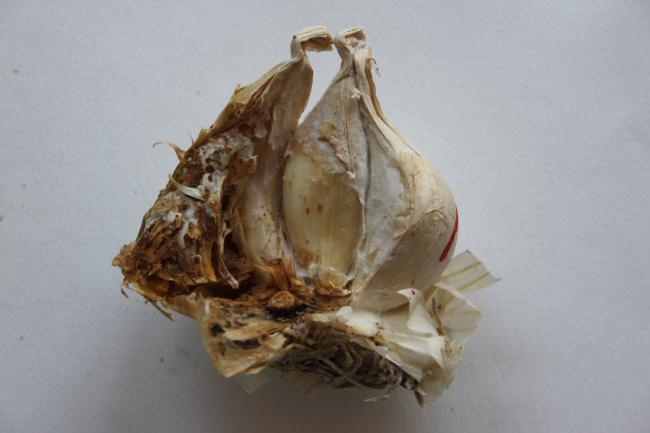Guidelines to counteract fusarium rot in piacenzawhite garlic

In recent years, Copap had increasing warnings regarding rotten garlic, especially during postharvest.
According to the limited amount of information available, the cause of this alteration is related to the fungi belonging to Fusarium spp, and specifically F. proliferatum. This fungus produces the micotoxins “fumonisins”, regulated in maize destined to human consumptionat European level; suggestions are also defined for feed destination. The main goal of the project is to create guidelines for the garlic production chain (both for seed and food destination) in order to prevent garlic from rotting and improve both the production’s quality and quantity
The activities of the project starts with a survey of current conditions in order to identify the critical points where it will be necessary to intervene. Then, good practices, both agronomical practices in field and those in post-harvest (drying, storage and processing), will be defined.These steps will be translated into guidelines, combined with a long term monitoring plan.
The final results will be disseminated to the farmers partners of COPAP through a course which will consider both teaching and coaching. A wider dissemination will be managed through COPAP’s website the organisation of two events/seminars and the publication of two popular articles in specific agriculture journals
COPAP is a cooperative constituted in 1976 in an area suited for the "white Piacenza garlic" cultivation, with the aim to produce and sell garlic, scallion, onion and tomatoes produced by the 23 associated farmers. In recent years, Copap has had increasing warnings regarding rotten garlic, especially during post-harvest. The cause of this alteration is related to the fungi belonging to Fusarium spp, and specifically F. proliferatum. This fungus produces the micotoxins “fumonisins”, regulated in maize destined to human consumption at a European level; suggestions are also defined for feed destination. To prevent the widespread of Fusarium, COPAP pays great attention to crop rotation and to the use of certified "seed".
Nontheless, maybe for agronomic and climatic causes, the diffusion of the Fusarium is enhancing both in the field and during drying, conservation and processing. Currently, the loss of garlic yield in the worst cases can reach up to 50-60% and the economic incidence on COPAP's balance sheet is on the average of about 30% .
This innovative project aims to define guidelines for the garlic chain, therefore involving both the farming process and the post-harvest mangement (drying/storage and processing stages) in order to control/prevent garlic rot.
The improvement expected from this project should also contribute in increasing the dividend paid to COPAP’s farm partners which will help to defend the profitability of this cultivation.
The result expected is to limit fusarium spread during garlic field cultivations and in storage/processing environments. The main specific objectives follows:
The first aim is to prevent the “White Piacenza Garlic” from disappearing from the local agriculture, avoiding the loss of both agro biodiversity and a typical local crop.
The second goal is to lower fungal inoculum taking into consideration the best agronomical practices, also in view of ongoing climatic changes, possibly involved in the increase of diseases caused by Fusaria .
The third objective, related to reducing the fungal incidence in all phases of garlic production/processing. This will lead to improve the working conditions of the employees involved in garlic storage and processing, and to improve food safety from a consumer point of view.
The improvements expected are:
1) reduction of garlic losses during storage and processing, with benefit both for farmers and the cooperative ;
2) improved working conditions in the processing rooms, with benefit for employees
3) improved quality and safety of the product sold, with benefit for consumers.
| Titolo/Descrizione | Url | Tipologia |
|---|---|---|
|
Guidelines to counteract fusarium rot in piacenza white garlic
|
Altro
|
|
|
Sito web del progetto
|
Sito web
|